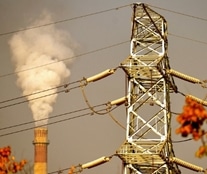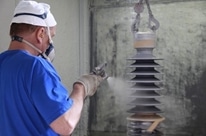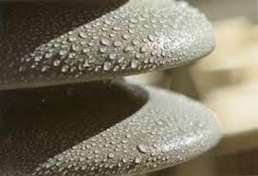New article by one of you who sent us his essay via email. Enjoy and let us know what you think in the comments.
Introduction to RTV polymeric coatings
Hydrophobic insulators are quite a requirement in the areas along coastal belts. Increased salt concentrations in the atmosphere damage the insulators in many ways. Elevated humidity also escalates this problem and a hydro-resistant surface coating is always an economical solution to this problem.

MV transmission line near a pollution source
Silicone and RTV polymeric coatings have proved their mettle in the field of electrical power distribution industry around the globe.
Application of RTV coated insulators

A worker coating a porcelain insulator in a factory
RTV (room temperature vulcanization) silicone coated insulators are best suitable for the following type of conditions:
- When some increment is required so as to compensate the water-related reduction of the creep-age distance
- When dealing with the presence of significant atmospheric contaminants i.e. coastal belts and industrial areas. RTV coated glass or porcelain insulators are hard as well as polymer like in the way they function. Adhesion of pollutants on the surface of coated insulator is significantly lesser than that of un-coated ones
- It is an ideal choice for significant reduction in cleaning and washing costs. RTV coated insulators do not require periodic cleaning or washing to wash off the contaminants and are a more economic choice over the normal insulators
- RTV coating is quite feasible for the transmission lines located near the radio broadcast installations. Presence of RTV polymeric layer significantly reduces the radio noise generated by the insulator strings
Drawbacks of RTV polymeric coatings
In spite of their effective pollution repellant nature and sleek appearance, RTV coated insulators pose following limitations with respect to their hydrophobic functions and economical aspects.
- Significant wastage of coating material during the application of RTV polymeric coating is a challenge for the contractors. Spraying is the only effective method of coating the polymeric layer and it causes huge loss of material. Thanks to continuous research, dip method is now dominating the RTV market.
- Thickness of the final RTV polymeric film remains between the 450-550 microns. RTV coating is not applicable where thicker layer is required.
- Periodic re application is required after every 7-9 years and it is a major drawback of the subject coating.
- Coating surface is weakly bonded and is prone to the damages from hail and sand storms.
- During prolonged wetting, the RTV coated surface temporarily loses its hydrophobic properties.
Feasibility with respect to the economic point of view
RTV coated insulators are more costly than those made of polymer material but have their own charm due to their rugged nature. RTV polymeric coating is more feasible in the areas where glass or porcelain type insulators are already installed. A periodic renewal after about 8-9 years keeps the coating reliable and maintenance free.

Hydrophobicity of RTV coated insulators
RTV coated hard insulators have their own market and utilization separate from the polymer ones. More research is underway and different type of coatings are rising in the global insulator market, very fast.
Where is the “Synchronization of Generators” article?
Hi there,
The most recent is here: http://engineering.electrical-equipment.org/energy-efficiency-solar/electrical-generators-synchronization-why-important-for-solar-pakistan.html
Hope it helped :)